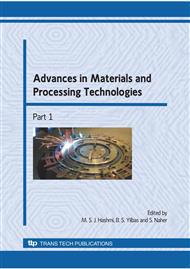p.214
p.222
p.230
p.237
p.244
p.250
p.261
p.269
p.275
Heuristics for Direct Slicing of Point Clouds for Layered Manufacturing
Abstract:
Reverse Engineering and Rapid Prototyping are integrated mostly using the tessellated STL (Solid-to-Layer) file. If copies of 3D scanned products are needed in a few time, the polygonization task is normally performed on the point cloud, often generating errors, requiring high computational effort, and heavy human intervention. In this paper it is proposed to overcome the limitations of polygonization by using direct slicing of point clouds, modelling the problem as a travelling salesman problem (TSP), solved basing on the heuristic technique called cheapest insertion. The point cloud is decomposed into elementary voxels, then, considering each Z level of the voxelized point cloud, the external non-void voxels are linked together, using the above mentioned heuristics, to generate the contour of the object with an automatic process. The contour of the object can be easily converted into commercial slice files suitable for Rapid Prototyping machines. The approach is applied to several complex shaped models to prove its robustness and efficiency.
Info:
Periodical:
Pages:
244-249
Citation:
Online since:
December 2009
Authors:
Price:
Сopyright:
© 2010 Trans Tech Publications Ltd. All Rights Reserved
Share:
Citation:


